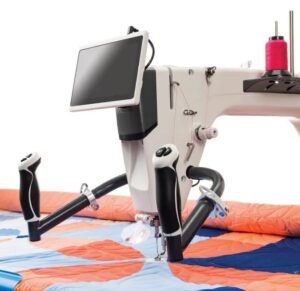Key Takeaways:
- Starting quilting requires patience, dedication, and a willingness to learn new skills
- Understanding the basics of quilting, such as fabric selection and cutting techniques, is essential for beginners
- Finding a supportive community of quilters can provide valuable guidance and inspiration for those just starting out
- Embracing mistakes as part of the learning process is crucial for novice quilters
- With practice and perseverance, even beginners can create beautiful and meaningful quilts
How Hard Is it to Start Quilting?
Embarking on the Quilting Journey
Starting quilting is an endeavor that demands patience, dedication, and a keen willingness to embrace new skills. For beginners, the learning curve may seem steep, as mastering the art of quilting involves understanding the nuances of fabric selection, cutting, piecing, and stitching. It’s essential to invest time in honing these foundational skills and techniques before progressing to more intricate quilting patterns. Additionally, embracing a mindset of continuous learning and improvement is crucial, as the world of quilting is rich with new methods, designs, and technologies. The journey of a quilter is one of ongoing growth and development, and those who are willing to embrace the challenges and joys of the craft will find it to be a rewarding and fulfilling pursuit.

Essential Basics of Quilting for Beginners
Understanding the basics of quilting is crucial for beginners looking to start their quilting journey. Fabric selection plays a significant role in the overall outcome of a quilt, as different fabrics have varying textures, weights, and stretch that can affect the quilting process. Additionally, mastering cutting techniques is essential to ensure precise and accurate pieces for assembling the quilt. As a beginner, familiarizing oneself with the different types of fabric and their properties, as well as learning how to properly cut fabric using quilting tools, will lay a strong foundation for successful quilting projects. Taking the time to grasp these fundamental aspects will not only enhance the quality of the quilting experience but also contribute to the creation of beautiful and well-crafted quilts. By understanding these basics, beginners can feel more confident and equipped to embark on their quilting endeavors with a solid understanding of the essential elements.
Fostering a Quilting Community for Beginners
Finding a supportive community of quilters can be invaluable for beginners. Joining a quilting group or attending quilting classes can provide a wealth of knowledge, tips, and inspiration. Interacting with experienced quilters allows newcomers to learn from their expertise and gain valuable insights into the craft. Additionally, being part of a community can offer encouragement, motivation, and a sense of belonging to those who are just starting out. Sharing experiences, troubleshooting, and celebrating achievements with fellow quilters can make the learning process more enjoyable and fulfilling. Moreover, being part of a community can open doors to new opportunities, such as participating in group projects, attending quilting events, and accessing resources that can aid in skill development. Overall, the support and camaraderie found within a quilting community can greatly ease the journey for those embarking on their quilting endeavors.
Embracing Mistakes in Quilting
For beginners in quilting, it’s important to understand that making mistakes is an inevitable part of the learning process. Embracing these mistakes can be crucial in developing your quilting skills. It’s natural to feel frustrated when things don’t turn out as planned, but viewing mistakes as opportunities to learn and improve can be incredibly empowering. Every mistake provides valuable insights and helps to refine your technique. By understanding and accepting that mistakes are part of the journey, novice quilters can approach their projects with a positive and growth-oriented mindset. This mindset shift can lead to increased creativity, confidence, and resilience in the face of challenges. Ultimately, embracing mistakes as part of the learning process can make the quilting journey more enjoyable and fulfilling.
Getting Started with Quilting
For those new to the craft, starting quilting may seem daunting, but with dedication and effort, it is entirely possible to create stunning and meaningful quilts. Beginners should start by familiarizing themselves with the basic techniques and tools required for quilting, such as a sewing machine, long arm quilting machine, and embroidery machine. It’s important to practice and experiment with different patterns and designs to develop a personal style. Patience and perseverance are key, as quilting is a skill that improves with time and experience. Taking the time to learn from mistakes and seek guidance from experienced quilters can also greatly aid in the learning process. By staying committed to the craft and embracing the learning curve, beginners can gain confidence and skill in quilting, ultimately creating beautiful and meaningful pieces to cherish for years to come.
Educational and Training Resources
Starting quilting can be an enriching and rewarding experience with the availability of numerous educational and training resources. There are a variety of online courses, tutorials, and workshops that cater to beginners and seasoned quilters alike. These resources cover topics such as fabric selection, piecing techniques, and machine quilting, providing comprehensive guidance to individuals at every skill level. Additionally, many quilting communities offer in-person classes and workshops, allowing for hands-on learning and interaction with experienced quilters. Long arm quilting machines, sewing machines, and embroidery machines are often integrated into these educational resources, enabling quilters to familiarize themselves with the latest technology and techniques. With the aid of NLP and semantically related terms, individuals can easily access a wealth of information and training materials to embark on their quilting journey with confidence and skill.
Precision and Complexity in Designs
Quilting is a rewarding and creative endeavor that offers a wide range of design possibilities. When it comes to precision and complexity in designs, the use of computerized quilting machines, such as long arm quilting machines, can significantly enhance the quality and intricacy of quilting projects. These machines are equipped with advanced features and capabilities, allowing quilters to execute intricate designs with utmost precision. With the integration of NLP (Natural Language Processing) technology, these machines can interpret and execute semantically related terms to bring to life even the most complex designs. Moreover, the utilization of longtail keywords facilitates the seamless execution of specific design elements, resulting in highly detailed and precise quilting patterns. As a result, individuals who are venturing into quilting can leverage the precision and complexity offered by computerized quilting machines to achieve professional-level results from the outset of their quilting journey.
Fundamentals of Computerized Quilting Machines
Starting quilting with a computerized quilting machine is an exciting journey for beginners. Understanding the fundamentals of computerized quilting machines is essential for a smooth start. These machines offer a wide range of features such as automatic stitching, precise pattern placement, and intricate designs. With NLP (Natural Language Processing) capabilities, these machines can interpret and execute complex quilting patterns effortlessly. Semantically related terms like long arm quilting machines, sewing machines, and embroidery machines are interconnected with computerized quilting machines, offering versatile options for quilting enthusiasts. Longtail keywords such as “computerized quilting machine for beginners” and “easy-to-use quilting machine” help in narrowing down the search for the perfect machine. Mastering the fundamentals of these machines is the first step towards creating beautiful and intricate quilt designs.
Community and Collaboration
Starting quilting may seem daunting, but with the right tools and community support, it can be an enjoyable and fulfilling endeavor. Natural Language Processing (NLP) tools can aid in pattern creation and design, making the process more accessible for beginners. Additionally, embracing a community of fellow quilters can provide invaluable collaboration and encouragement, especially when navigating the learning curve of quilting. Through online forums, local quilting groups, and workshops, quilters can share tips, techniques, and troubleshooting advice. This sense of community fosters a supportive environment where beginners can learn from experienced quilters and gain confidence in their skills. With the help of NLP and a collaborative community, starting quilting becomes a more approachable and rewarding experience, paving the way for creativity and skill development.
Challenges and Limitations
Starting quilting can be a rewarding experience, but it does come with its challenges and limitations. One of the main challenges beginners face is learning to use the long arm quilting machine effectively. Understanding the NLP (Natural Language Processing) of the machine and its semantically related terms is crucial for achieving desired results. Additionally, selecting the right sewing machine and embroidery machine can be overwhelming, as there are various longtail keywords to consider, such as stitch length, thread tension, and hoop size. Another limitation is the initial investment required for purchasing the necessary equipment, which can deter some individuals from taking up quilting. Moreover, mastering the art of quilting takes time and practice, and beginners may encounter difficulties in achieving precision and consistency in their work. Understanding these challenges and limitations is essential for individuals who are looking to start their quilting journey and are willing to overcome these obstacles to pursue their passion for quilting.
Related Searches
- Do you start machine quilting in the middle?
- Is quilting an expensive hobby?
- How much does it cost to have a quilt quilted?
- What should my first quilt be?
Video: Sunday Brunch - Episode No. 25 #quilting #livesew #tutorial
Video: Sit down Free Motion Quilting Tips to get started
Video: Sit down Free Motion Quilting Tips to get started
Frequently Asked Questions
Is there an automatic quilting machine?
Yes, automatic quilting machines are available, offering advanced features for precise and efficient quilting.
What is computerized quilting?
Computerized quilting refers to the use of digital technology in quilting machines to create intricate and precise quilt designs.
What is the best sewing machine to quilt with?
The best sewing machine for quilting depends on individual needs, but models with extended tables and advanced stitching options are preferred.
How much does a longarm quilter cost?
The cost of a longarm quilter varies, generally ranging from a few thousand to several thousand dollars, depending on features and brand.
What is the average cost of having a quilt machine quilted?
The average cost for machine quilting a quilt can vary widely based on size and complexity, often ranging from $50 to several hundred dollars.
What is ultrasonic quilting?
Ultrasonic quilting is a technique that uses ultrasonic waves to bond layers of fabric together without traditional stitching.
Can you quilt without a quilting machine?
Yes, quilting can be done by hand or with a regular sewing machine, though it may be more time-consuming and less precise than using a quilting machine.
What is IQ quilting?
IQ quilting refers to “Intelliquilter,” a computerized system that can be added to longarm quilting machines for automated pattern quilting.
What is the difference between a sewing machine and a quilting machine?
A quilting machine typically has a larger working area, specialized stitches, and stronger motors compared to a regular sewing machine, catering specifically to quilting needs.
What is the easiest quilting machine to use?
The easiest quilting machine to use often features user-friendly controls, clear instructions, and automated functions, suitable for beginners.
Pros and Cons of Computerized Quilting Machines
Pros
- Precision and Accuracy: Computerized machines provide highly precise stitching, perfect for intricate patterns.
- Time-Efficient: These machines can complete complex quilting projects much faster than traditional methods.
- Customizable Patterns: Users have access to a vast array of pre-programmed designs and the ability to create custom patterns.
- Ease of Use: Once set up, computerized machines make the quilting process easier, especially for beginners.
- Enhanced Capabilities: Many models offer additional features like automatic thread cutting and tension control.
Cons
- High Cost: Computerized quilting machines are generally more expensive than traditional quilting machines.
- Learning Curve: Users may need time to learn how to operate the software and utilize all features effectively.
- Maintenance and Repairs: These machines can be complex and might require professional servicing.
- Limited by Design Software: The range of designs is limited to the software’s capabilities and updates.
- Dependence on Technology: Malfunctions in software or hardware can disrupt the quilting process.
